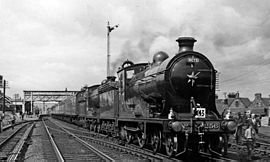Waverley Line
| Waverley Route | |||
|---|---|---|---|

NBR K Class No. 256 Glen Douglas at St Boswells in 1961.
|
|||
| Overview | |||
| Type | Heavy rail | ||
| System | National Rail | ||
| Status | Partially open | ||
| Locale |
Edinburgh, Midlothian, Borders, Carlisle Great Britain |
||
| Termini |
Edinburgh Waverley Carlisle Citadel |
||
| Operation | |||
| Opened | 1849 | ||
| Closed | 1969 | ||
| Technical | |||
| Line length | 98 1⁄4 mi (158.1 km) | ||
| Track gauge | 4 ft 8 1⁄2 in (1,435 mm) | ||
|
|||
The Waverley Route was a railway line that ran south from Edinburgh, through Midlothian and the Scottish Borders, to Carlisle. The line was built by the North British Railway; the stretch from Edinburgh to Hawick opened in 1849 and the remainder to Carlisle opened in 1862. The line was named after a series of novels by Sir Walter Scott.
The line was closed in 1969, as a result of the Beeching Report. Part of the line, from Edinburgh to Tweedbank, reopened in September 2015. The reopened railway is known as the Borders Railway.
The North British Railway (NBR) was established on 4 July 1844 when Parliamentary authorisation was given for the construction of a 57-mile-30-chain (92.3 km) line from Edinburgh to Berwick-upon-Tweed with a 4-mile-50-chain (7.4 km) branch to Haddington. The company's chairman and founder was John Learmonth, the chairman of the Edinburgh and Glasgow Railway, whose ambition it was to enclose the triangle of land between Edinburgh, Berwick and Carlisle with NBR rails. Carlisle was a key railway centre where a cross-border link with the Lancaster and Carlisle Railway could be established.
The NBR's Edinburgh-Berwick line was to be the starting point for the route which would run diagonally across the Southern Uplands to the Solway Plain and Carlisle, a distance of some 98 miles (158 km). The first step in establishing the line was the acquisition of the Edinburgh and Dalkeith Railway (E&DR), a local line opened in 1831 which ran from an inconveniently-sited station at St Leonards on the southern extremity of Edinburgh to Dalhousie on the Lothian Coalfield. The E&DR, which had been authorised on 26 May 1826 as a tramway to carry coal to the Firth of Forth at Fisherrow and, later, Leith, ran for a distance of 8 1⁄2 miles (13.7 km) with branches eastwards to Leith and Fisherrow from Wanton Walls. The proprietors of the E&DR viewed the NBR's overtures with some alarm as they feared the loss of their valuable coal traffic; thought was given to extending the E&DR to meet the Edinburgh and Glasgow or the projected Caledonian Main Line but the proprietors' concerns were assuaged by the NBR's generous offer of £113,000 for the outright purchase of the line and the sale was completed in October 1845.
...
Wikipedia

